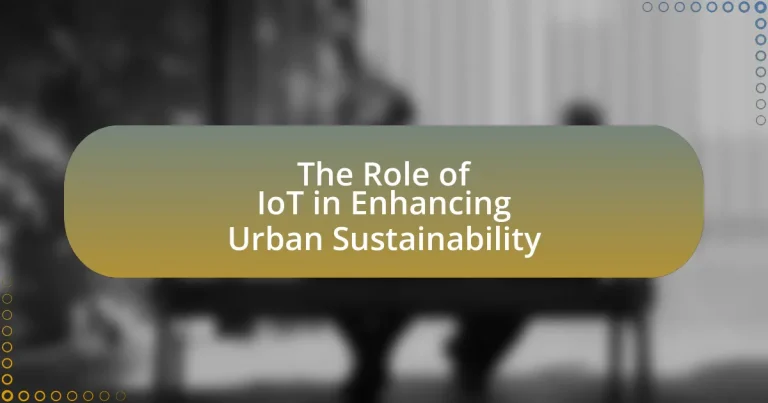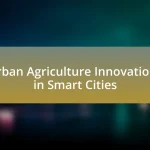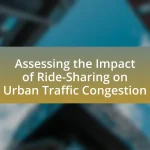The article focuses on the role of the Internet of Things (IoT) in enhancing urban sustainability. It outlines how IoT technologies, such as smart sensors and connected infrastructure, facilitate efficient resource management, reduce environmental impact, and improve the quality of life in urban areas. Key applications discussed include smart waste management, energy-efficient buildings, and intelligent transportation systems, all of which contribute to reduced carbon emissions and operational costs. The article also addresses the challenges cities face in implementing IoT solutions, such as data privacy concerns and infrastructure costs, while highlighting best practices and future trends for successful integration.
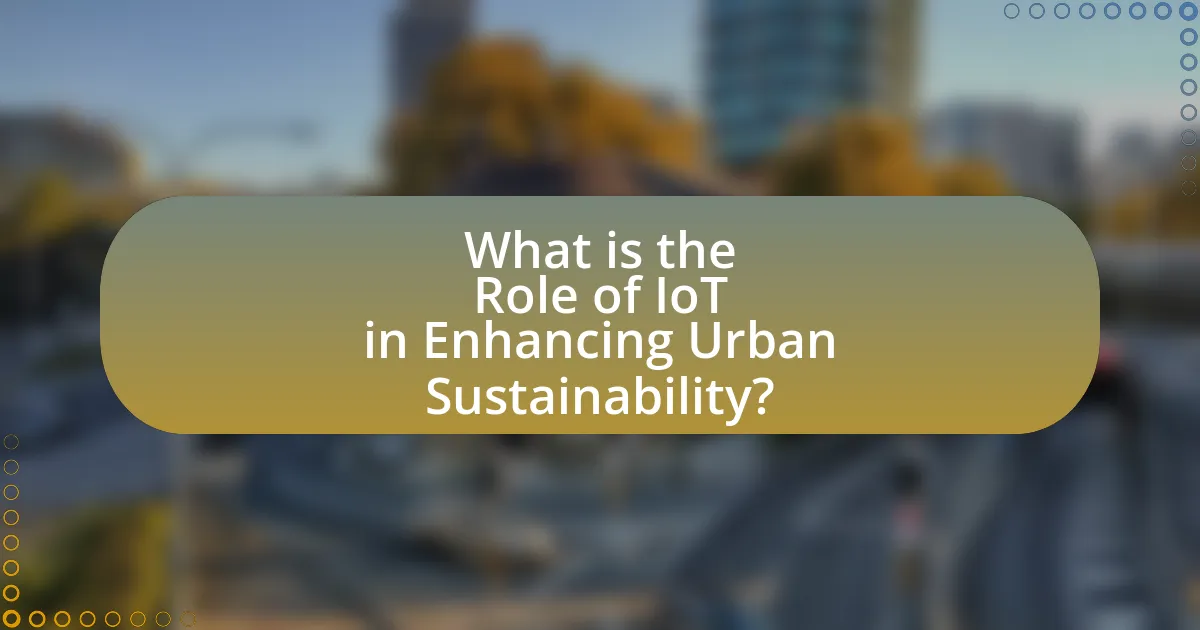
What is the Role of IoT in Enhancing Urban Sustainability?
The Internet of Things (IoT) plays a crucial role in enhancing urban sustainability by enabling real-time data collection and analysis to optimize resource management. IoT devices, such as smart sensors and connected infrastructure, facilitate efficient energy use, waste management, and transportation systems. For instance, smart grids can reduce energy consumption by 10-30% through demand response and load balancing, while smart waste management systems can decrease operational costs by up to 50% by optimizing collection routes. These technologies contribute to reduced carbon emissions and improved quality of life in urban areas, demonstrating the significant impact of IoT on sustainable urban development.
How does IoT contribute to sustainable urban development?
IoT contributes to sustainable urban development by enabling efficient resource management and reducing environmental impact. Through smart sensors and connected devices, cities can monitor energy consumption, optimize waste management, and improve traffic flow. For instance, smart lighting systems adjust brightness based on real-time data, leading to energy savings of up to 50%. Additionally, IoT applications in water management can detect leaks and reduce water waste, which is crucial in urban areas facing water scarcity. These technologies collectively enhance urban sustainability by promoting resource efficiency and minimizing carbon footprints.
What are the key IoT technologies used in urban sustainability?
Key IoT technologies used in urban sustainability include smart sensors, data analytics platforms, and connected devices. Smart sensors monitor environmental parameters such as air quality, noise levels, and energy consumption, providing real-time data that informs urban planning and management. Data analytics platforms process this information to identify trends and optimize resource allocation, enhancing efficiency in public services. Connected devices, such as smart streetlights and waste management systems, facilitate automated responses to urban challenges, improving overall sustainability. These technologies collectively contribute to reducing carbon footprints and enhancing the quality of urban life.
How do these technologies integrate with urban infrastructure?
IoT technologies integrate with urban infrastructure by enabling real-time data collection and analysis, which enhances operational efficiency and sustainability. For instance, smart sensors monitor traffic flow, allowing cities to optimize traffic signals and reduce congestion, thereby lowering emissions. Additionally, IoT devices in waste management systems can track bin levels, facilitating efficient collection routes and reducing unnecessary trips. According to a report by McKinsey, cities that implement IoT solutions can reduce energy consumption by up to 30%, demonstrating the significant impact of these technologies on urban sustainability.
Why is urban sustainability important in today’s context?
Urban sustainability is crucial in today’s context because it addresses the pressing challenges of rapid urbanization, climate change, and resource depletion. As more than half of the global population now resides in urban areas, sustainable practices are essential to ensure that cities can support their inhabitants while minimizing environmental impact. For instance, according to the United Nations, urban areas are responsible for approximately 70% of global greenhouse gas emissions. Implementing urban sustainability initiatives can significantly reduce these emissions, enhance quality of life, and promote economic resilience.
What challenges do cities face regarding sustainability?
Cities face significant challenges regarding sustainability, including resource management, pollution control, and social equity. Resource management is critical as urban areas often struggle with water scarcity and energy consumption; for instance, the United Nations reports that cities consume over two-thirds of the world’s energy and account for more than 70% of CO2 emissions. Pollution control remains a pressing issue, with urban air quality often exceeding safe levels, leading to health problems for residents. Additionally, social equity challenges arise as marginalized communities frequently lack access to sustainable resources and services, exacerbating inequalities. These interconnected issues highlight the complexity of achieving sustainability in urban environments.
How can IoT address these sustainability challenges?
IoT can address sustainability challenges by enabling real-time data collection and analysis, which optimizes resource management. For instance, smart sensors in waste management systems can monitor bin levels, leading to more efficient collection routes and reduced fuel consumption. According to a study by the International Telecommunication Union, implementing IoT solutions in urban environments can lead to a 30% reduction in energy consumption and a 20% decrease in greenhouse gas emissions. This demonstrates that IoT not only enhances operational efficiency but also contributes significantly to urban sustainability goals.
What are the potential impacts of IoT on urban environments?
The potential impacts of IoT on urban environments include improved resource management, enhanced public safety, and increased efficiency in urban services. IoT technologies enable real-time data collection and analysis, allowing cities to optimize energy consumption, reduce waste, and manage traffic flow more effectively. For instance, smart lighting systems can adjust brightness based on pedestrian presence, leading to energy savings of up to 30%. Additionally, IoT applications in public safety, such as connected surveillance cameras and emergency response systems, can significantly reduce crime rates and improve emergency response times. According to a report by McKinsey, cities that implement IoT solutions can enhance their operational efficiency by 30% or more, demonstrating the transformative potential of IoT in urban sustainability.
How does IoT improve resource management in cities?
IoT improves resource management in cities by enabling real-time data collection and analysis, which enhances decision-making and operational efficiency. For instance, smart sensors monitor water usage, allowing municipalities to detect leaks and reduce waste, leading to a reported 20-30% decrease in water consumption in cities that have implemented such systems. Additionally, IoT applications in waste management optimize collection routes based on fill levels, resulting in a 30% reduction in fuel consumption for waste collection vehicles. These advancements demonstrate how IoT technologies facilitate more sustainable urban resource management through increased efficiency and reduced waste.
What role does IoT play in enhancing public services?
IoT significantly enhances public services by enabling real-time data collection and analysis, which improves decision-making and resource allocation. For instance, smart waste management systems utilize IoT sensors to monitor waste levels in bins, optimizing collection routes and reducing operational costs. According to a study by the McKinsey Global Institute, cities that implement IoT solutions can reduce costs by up to 30% while improving service delivery. This integration of IoT in public services leads to increased efficiency, better citizen engagement, and enhanced overall urban sustainability.
How can IoT facilitate citizen engagement in urban sustainability?
IoT can facilitate citizen engagement in urban sustainability by providing real-time data and interactive platforms that empower residents to participate in decision-making processes. For instance, smart sensors can monitor air quality, waste management, and energy consumption, allowing citizens to access this information through mobile applications. This transparency encourages community involvement in sustainability initiatives, as evidenced by the City of Barcelona’s use of IoT to engage citizens in urban planning, resulting in increased public participation and awareness of environmental issues.
What platforms enable citizen participation through IoT?
Platforms that enable citizen participation through IoT include Smart Citizen, CityPulse, and Participatory Budgeting platforms. Smart Citizen allows individuals to collect and share environmental data, fostering community engagement in urban planning. CityPulse integrates real-time data from various sources to enhance public services and citizen involvement in decision-making. Participatory Budgeting platforms utilize IoT data to empower citizens in budget allocation processes, ensuring transparency and community input. These platforms exemplify how IoT can facilitate active citizen participation in urban sustainability initiatives.
How does citizen feedback influence IoT implementations?
Citizen feedback significantly influences IoT implementations by ensuring that the technology aligns with the needs and preferences of the community. This feedback helps identify specific urban challenges, allowing IoT solutions to be tailored effectively. For instance, cities that have integrated citizen input into their smart city projects, such as Barcelona and Amsterdam, have reported improved public satisfaction and increased efficiency in services like waste management and traffic control. Research indicates that when citizens are engaged in the design and deployment of IoT systems, the resulting applications are more likely to address real-world issues, leading to enhanced urban sustainability outcomes.
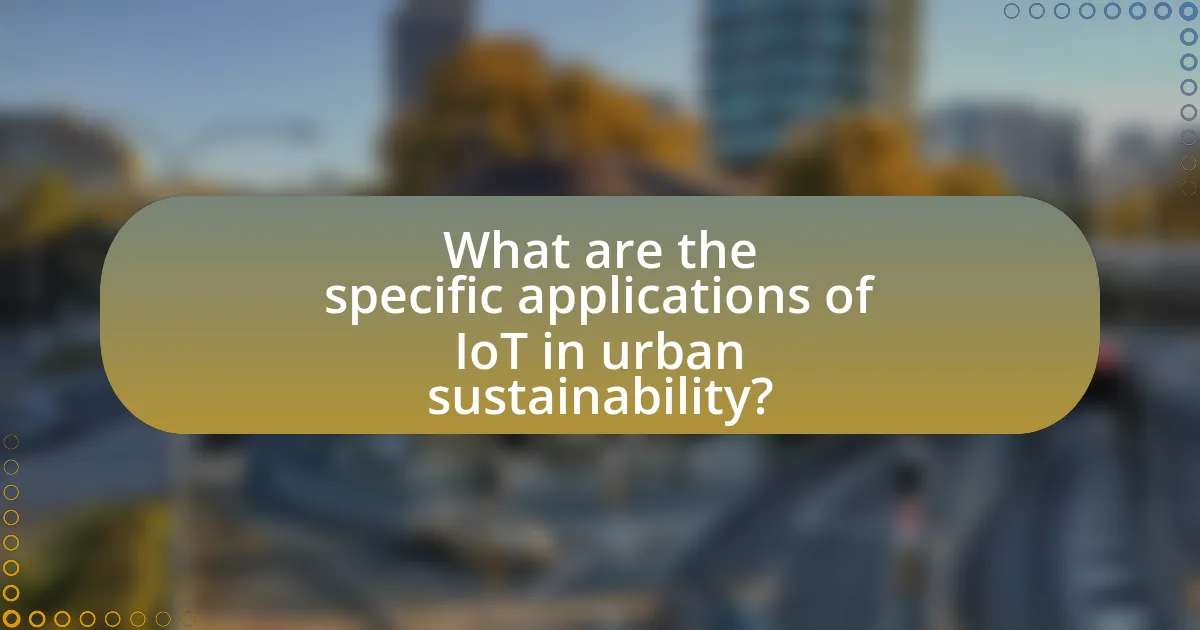
What are the specific applications of IoT in urban sustainability?
The specific applications of IoT in urban sustainability include smart waste management, energy-efficient buildings, intelligent transportation systems, and environmental monitoring. Smart waste management utilizes IoT sensors to optimize collection routes and reduce operational costs, leading to a more efficient waste disposal process. Energy-efficient buildings employ IoT devices to monitor and control energy consumption, significantly lowering carbon footprints. Intelligent transportation systems leverage IoT data to improve traffic flow and reduce congestion, enhancing urban mobility. Environmental monitoring uses IoT sensors to track air quality and noise levels, enabling cities to address pollution effectively. These applications demonstrate how IoT technologies contribute to sustainable urban development by improving resource management and enhancing the quality of life for residents.
How is IoT used in smart transportation systems?
IoT is used in smart transportation systems to enhance efficiency, safety, and sustainability by enabling real-time data collection and communication between vehicles, infrastructure, and users. For instance, connected vehicles can share information about traffic conditions, which helps in optimizing routes and reducing congestion. According to a study by the International Transport Forum, implementing IoT solutions in urban transport can lead to a 15% reduction in travel time and a significant decrease in emissions. Additionally, smart traffic lights can adjust their timing based on real-time traffic flow, further improving traffic management and reducing idle times.
What technologies support smart traffic management?
Smart traffic management is supported by technologies such as the Internet of Things (IoT), artificial intelligence (AI), big data analytics, and connected vehicle systems. IoT devices, including sensors and cameras, collect real-time traffic data, enabling dynamic traffic signal control and congestion management. AI algorithms analyze this data to predict traffic patterns and optimize routing. Big data analytics processes vast amounts of information from various sources, enhancing decision-making for traffic flow improvements. Connected vehicle systems facilitate communication between vehicles and infrastructure, further improving traffic efficiency and safety. These technologies collectively contribute to more sustainable urban mobility by reducing congestion and emissions.
How do smart transportation systems reduce emissions?
Smart transportation systems reduce emissions by optimizing traffic flow and enhancing public transit efficiency. These systems utilize real-time data from sensors and IoT devices to manage traffic signals, reduce congestion, and promote the use of public transportation. For instance, studies show that cities implementing smart traffic management can decrease vehicle emissions by up to 30% due to improved traffic conditions and reduced idle times. Additionally, smart transportation encourages the adoption of electric vehicles and car-sharing services, further contributing to lower overall emissions.
What role does IoT play in energy management in cities?
IoT plays a crucial role in energy management in cities by enabling real-time monitoring and optimization of energy consumption. Through smart sensors and connected devices, cities can collect data on energy usage patterns, allowing for more efficient distribution and reduced waste. For instance, a study by the International Energy Agency found that implementing IoT solutions can lead to energy savings of up to 30% in urban environments. This data-driven approach facilitates better decision-making for energy providers and consumers alike, ultimately contributing to enhanced urban sustainability.
How do smart grids utilize IoT for energy efficiency?
Smart grids utilize IoT by integrating connected devices to monitor and manage energy consumption in real-time, enhancing energy efficiency. These IoT devices, such as smart meters and sensors, collect data on energy usage patterns, enabling utilities to optimize energy distribution and reduce waste. For instance, a study by the U.S. Department of Energy indicates that smart grid technologies can lead to a 10-15% reduction in energy consumption through improved demand response and load management. This data-driven approach allows for better forecasting of energy needs and facilitates the integration of renewable energy sources, further promoting sustainability in urban environments.
What are the benefits of IoT-enabled renewable energy sources?
IoT-enabled renewable energy sources enhance efficiency, reliability, and sustainability in energy management. By integrating IoT technology, these systems can monitor energy production and consumption in real-time, allowing for optimized energy distribution and reduced waste. For instance, smart grids utilize IoT sensors to balance supply and demand dynamically, which can lead to a 10-30% increase in energy efficiency, according to the International Energy Agency. Additionally, IoT devices facilitate predictive maintenance, reducing downtime and operational costs by up to 20%. This integration ultimately supports urban sustainability goals by promoting cleaner energy usage and reducing carbon footprints.
How does IoT contribute to waste management solutions?
IoT contributes to waste management solutions by enabling real-time monitoring and data collection of waste levels in bins and containers. This technology allows municipalities to optimize collection routes and schedules, reducing operational costs and environmental impact. For instance, a study by the World Economic Forum highlighted that cities implementing IoT waste management systems can reduce collection costs by up to 30% and decrease greenhouse gas emissions by minimizing unnecessary trips. Additionally, IoT sensors can provide insights into waste composition, facilitating better recycling practices and resource recovery.
What technologies are involved in smart waste collection?
Smart waste collection involves several key technologies, including IoT sensors, GPS tracking, data analytics, and mobile applications. IoT sensors are installed in waste bins to monitor fill levels in real-time, enabling efficient collection routes. GPS tracking systems optimize waste collection vehicles’ routes based on current traffic conditions and bin fill levels. Data analytics processes the information gathered from sensors to predict waste generation patterns and improve operational efficiency. Mobile applications facilitate communication between waste management authorities and citizens, allowing for reporting of issues and collection schedules. These technologies collectively enhance urban sustainability by reducing fuel consumption and minimizing landfill overflow.
How does IoT optimize recycling processes in urban areas?
IoT optimizes recycling processes in urban areas by enabling real-time monitoring and data collection on waste management. Smart bins equipped with sensors can detect fill levels, allowing for efficient collection routes and schedules, which reduces operational costs and carbon emissions. For instance, a study by the Massachusetts Institute of Technology found that implementing IoT solutions in waste management can lead to a 30% reduction in collection costs and a 20% increase in recycling rates. Additionally, IoT platforms can analyze data to improve sorting processes and enhance public awareness about recycling, ultimately contributing to more sustainable urban environments.
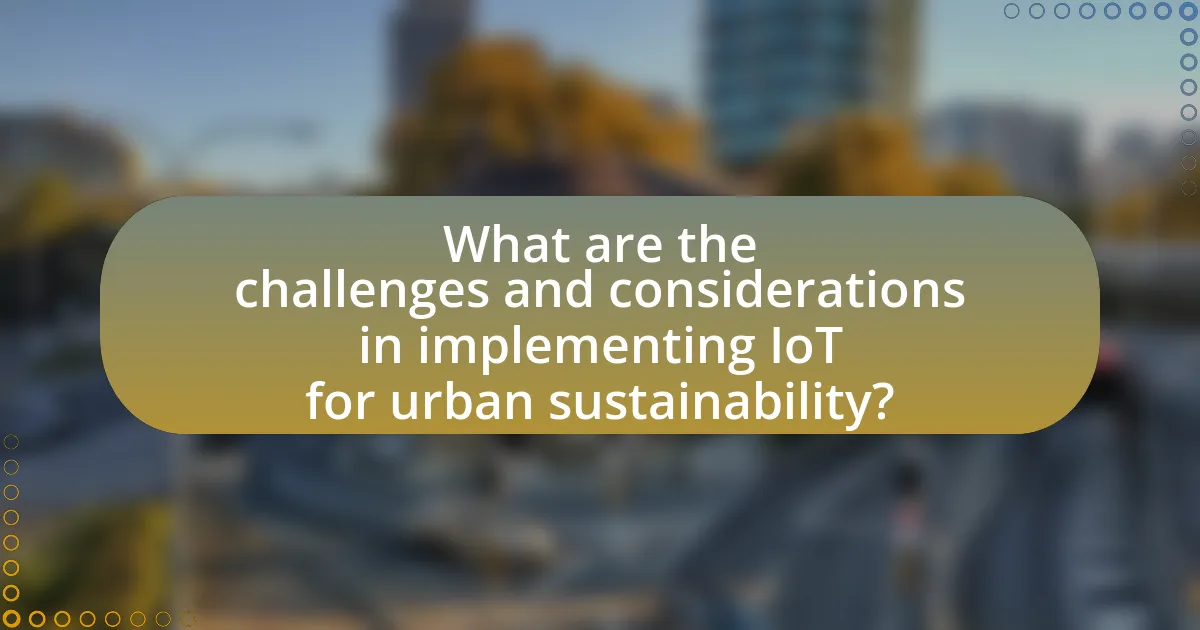
What are the challenges and considerations in implementing IoT for urban sustainability?
The challenges and considerations in implementing IoT for urban sustainability include data privacy, interoperability, infrastructure costs, and scalability. Data privacy concerns arise as IoT devices collect sensitive information, necessitating robust security measures to protect citizen data. Interoperability issues occur when different IoT systems and devices fail to communicate effectively, hindering seamless integration. Infrastructure costs can be significant, as cities must invest in new technologies and maintenance, which may strain budgets. Scalability is also a concern, as solutions must be adaptable to growing urban populations and evolving technologies. These factors collectively impact the successful deployment of IoT solutions aimed at enhancing urban sustainability.
What are the main barriers to IoT adoption in urban settings?
The main barriers to IoT adoption in urban settings include high implementation costs, lack of standardization, data privacy concerns, and insufficient infrastructure. High implementation costs deter municipalities from investing in IoT technologies, as initial expenses can be substantial. Lack of standardization across devices and platforms complicates integration, leading to interoperability issues. Data privacy concerns arise from the collection and management of sensitive information, making stakeholders hesitant to adopt IoT solutions. Additionally, insufficient infrastructure, such as inadequate internet connectivity and outdated systems, hampers the effective deployment of IoT technologies in urban environments. These barriers collectively hinder the widespread adoption of IoT, impacting urban sustainability efforts.
How do data privacy concerns affect IoT implementations?
Data privacy concerns significantly hinder IoT implementations by creating barriers to data sharing and user trust. When individuals fear that their personal information may be misused or inadequately protected, they are less likely to adopt IoT devices, which can limit the technology’s potential benefits for urban sustainability. For instance, a survey by the Pew Research Center found that 81% of Americans feel that the risks of data collection by companies outweigh the benefits, indicating widespread apprehension about privacy. This skepticism can lead to stricter regulations and compliance requirements, which may slow down the deployment of IoT solutions designed to enhance urban sustainability, such as smart waste management and energy-efficient systems.
What infrastructure is necessary for effective IoT deployment?
Effective IoT deployment requires a robust infrastructure that includes reliable connectivity, data processing capabilities, and security measures. Reliable connectivity, such as 5G networks or Wi-Fi, ensures seamless communication between devices, which is essential for real-time data exchange. Data processing capabilities, including cloud computing and edge computing, enable efficient data analysis and storage, allowing for quick decision-making. Security measures, such as encryption and authentication protocols, protect sensitive data and maintain user privacy. These components collectively support the scalability and functionality of IoT systems, facilitating their integration into urban sustainability initiatives.
How can cities overcome these challenges?
Cities can overcome challenges related to urban sustainability by implementing Internet of Things (IoT) technologies to optimize resource management and enhance operational efficiency. For instance, smart sensors can monitor energy consumption in real-time, allowing cities to reduce waste and lower costs. According to a report by McKinsey, cities that adopt IoT solutions can achieve up to a 30% reduction in energy usage. Additionally, IoT can facilitate better traffic management through connected vehicles and smart traffic lights, which can decrease congestion and improve air quality. The integration of these technologies not only addresses immediate urban challenges but also supports long-term sustainability goals.
What best practices can guide successful IoT integration?
Successful IoT integration can be guided by best practices such as ensuring interoperability, prioritizing security, and implementing scalable architectures. Interoperability is crucial as it allows different IoT devices and systems to communicate effectively, which is supported by the adoption of standardized protocols like MQTT and CoAP. Security must be prioritized to protect sensitive data and maintain user trust; for instance, implementing end-to-end encryption and regular software updates can mitigate vulnerabilities. Additionally, scalable architectures enable systems to grow and adapt to increasing data loads and device numbers, which is essential for urban environments where IoT applications can expand rapidly. These practices collectively enhance the effectiveness and reliability of IoT solutions in urban sustainability initiatives.
How can collaboration between stakeholders enhance IoT initiatives?
Collaboration between stakeholders enhances IoT initiatives by fostering shared resources, expertise, and data, which leads to more effective and innovative solutions. When various stakeholders, such as government agencies, private companies, and community organizations, work together, they can pool their knowledge and technology to address urban sustainability challenges more comprehensively. For instance, a study by the International Telecommunication Union found that collaborative IoT projects can reduce operational costs by up to 30% and improve service delivery efficiency. This synergy not only accelerates the deployment of IoT technologies but also ensures that the solutions are tailored to meet the specific needs of urban environments, ultimately driving sustainable development.
What are the future trends of IoT in urban sustainability?
Future trends of IoT in urban sustainability include increased integration of smart sensors for real-time data collection, enhanced energy management systems, and improved waste management solutions. Smart sensors will enable cities to monitor air quality, traffic patterns, and energy consumption, leading to more informed decision-making. For instance, cities like Barcelona have implemented smart lighting systems that adjust based on pedestrian activity, reducing energy waste by up to 30%. Additionally, IoT-enabled waste management systems, such as those used in Seoul, optimize collection routes based on bin fill levels, improving efficiency and reducing emissions. These advancements demonstrate how IoT can significantly contribute to sustainable urban development by promoting resource efficiency and reducing environmental impact.
How will advancements in technology shape IoT applications?
Advancements in technology will significantly enhance IoT applications by improving connectivity, data processing, and energy efficiency. For instance, the rollout of 5G networks will enable faster data transmission and lower latency, allowing IoT devices to communicate in real-time, which is crucial for applications like smart traffic management and environmental monitoring. Additionally, developments in edge computing will facilitate local data processing, reducing the need for centralized cloud resources and improving response times for critical applications. Furthermore, innovations in artificial intelligence and machine learning will enable IoT systems to analyze vast amounts of data more effectively, leading to smarter decision-making in urban sustainability initiatives, such as optimizing energy consumption in smart buildings. These technological advancements collectively drive the evolution of IoT applications, making them more efficient and impactful in enhancing urban sustainability.
What role will policy play in the future of IoT in cities?
Policy will play a crucial role in shaping the future of IoT in cities by establishing regulatory frameworks that ensure data privacy, security, and interoperability among devices. Effective policies will facilitate the integration of IoT technologies into urban infrastructure, promoting sustainable practices such as energy efficiency and waste management. For instance, cities like Barcelona have implemented policies that support smart lighting and waste collection systems, demonstrating how regulatory measures can enhance urban sustainability through IoT. These policies not only guide technological adoption but also address public concerns, ensuring that IoT solutions contribute positively to urban living conditions.
What practical steps can cities take to leverage IoT for sustainability?
Cities can leverage IoT for sustainability by implementing smart waste management systems, which utilize sensors to optimize collection routes and reduce fuel consumption. For example, cities like Barcelona have deployed IoT-enabled bins that signal when they are full, leading to a 20% reduction in waste collection costs. Additionally, cities can adopt smart energy grids that monitor and manage energy consumption in real-time, improving efficiency and reducing carbon emissions. Research from the International Energy Agency indicates that smart grids can enhance energy efficiency by up to 30%. Furthermore, cities can utilize IoT for smart water management, employing sensors to detect leaks and monitor usage, which can lead to a 15% reduction in water waste, as evidenced by initiatives in Singapore. These practical steps demonstrate how IoT can significantly contribute to urban sustainability efforts.
How can urban planners effectively incorporate IoT solutions?
Urban planners can effectively incorporate IoT solutions by integrating smart sensors and data analytics into urban infrastructure to enhance decision-making and resource management. For instance, deploying IoT-enabled sensors in traffic systems allows for real-time monitoring and optimization of traffic flow, which can reduce congestion and emissions. A study by the McKinsey Global Institute found that smart traffic management systems can reduce travel times by up to 30%, demonstrating the tangible benefits of IoT integration. Additionally, urban planners can utilize IoT for smart waste management, where sensors in waste bins signal when they need to be emptied, optimizing collection routes and reducing operational costs. This approach not only improves efficiency but also contributes to sustainability goals by minimizing waste and resource use.
What resources are available for cities to start IoT initiatives?
Cities can access various resources to initiate IoT initiatives, including government grants, public-private partnerships, and technology frameworks. For instance, the Smart Cities Challenge, funded by the U.S. Department of Transportation, provides financial support for cities to develop smart infrastructure. Additionally, organizations like the International Telecommunication Union offer guidelines and best practices for implementing IoT solutions. Furthermore, platforms such as Cisco’s Smart+Connected Communities provide technological tools and resources tailored for urban environments. These resources collectively enable cities to effectively plan and execute IoT projects aimed at enhancing urban sustainability.
